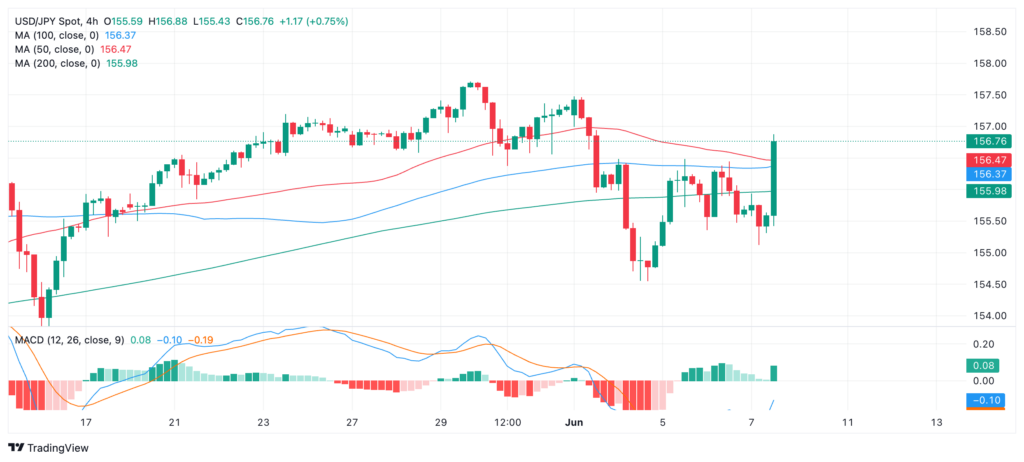USDJPY spiked higher by over half a percent just after the release of US nonfarm payrolls (NFP) data, on Friday. USDJPY traded in the upper 156s after the US Dollar strengthened as a result of the better-than-expected results.
Nonfarm payrolls showed the number of employed people in the US rose by 272,000 in May, when 185,000 had been expected, according to data from the US Bureau of Statistics (BLS). The result was higher than the April figure which was revised down to 165,000.

USD/JPY Daily Chart
The BLS report showed a rise in Average Hourly Earnings of 4.1% YoY, beating estimates of 3.9% and higher than the revised-up 4.0% in April.
The report showed the Unemployment Rate rose to 4.0%, however, when 3.9% had been forecast from 3.9% previously.
The data overall suggests the US labour market is in better shape than had previously been thought, especially given the lower-than-expected JOLTS Job Openings and ADP payrolls data earlier in the week.
The higher-than-expected wage inflation indicates the possibility headline and core inflation might rise as workers spend their increased wages.
Higher general inflation could deter the US Federal Reserve from lowering interest rates. Prior to the NFP release, the probability of the Fed cutting interest rates in September was roughly 67% – after the NFPs it had fallen to 53%.
Maintaining high interest rates is positive for USDJPY as it strengthens the Dollar. A higher interest rate attracts greater inflows of foreign capital, increasing demand for the currency.
Japanese wage data
USD/JPY’s strong move up following the NFP data may be exaggerated because it follows two negative minor US employment reports earlier in the week (JOLTS and ADP) and because of the contrast with similar data from Japan.
Real wages in Japan declined for the 25th straight month in April, as domestic inflation continued to outpace wage growth. The data makes it harder for the Bank of Japan (BoJ) to normalise its monetary policy.
The BoJ is the only major central bank still undertaking quantitative easing (QE) and has had to keep interest rates in an ultra-low 0.0% – 0.1% range. This has led to a stark devaluation in the Yen to levels which raise concern among policymakers as they are hampering business activity.
That said, USDJPY lost ground earlier in the week amid rumours the BoJ was planning to reduce the bond purchases it makes as part of its QE programme. If the BoJ cuts bond purchases it would put upward pressure on Japanese bond yields which are highly correlated to the JPY. It remains to be seen, however, whether the rumours materialise.
USDJPY upside may be capped by direct intervention from the Japanese authorities to buy the Yen in the FX markets.
On Tuesday, Deputy Governor of the BoJ, Ryozo Himino, repeated concerns about how a weak JPY was negatively impacting the economy and the bank needed to be “very vigilant” regarding its effects. His comments suggested the BoJ might be preparing for another direct intervention in Forex markets to prop up JPY (negative for USDJPY).
According to Himino, the weak Yen pushes up inflation, but in a negative way. Although it increases the price of imported goods, continued stagnant wages mean consumers are increasingly being priced out of the market.
Himino said he would prefer inflation to come from higher wages, not a weak currency, as this would lead to a more dynamic economy.
(Source: OANDA)







